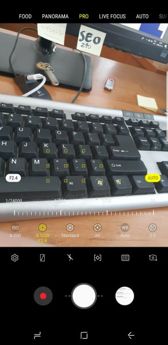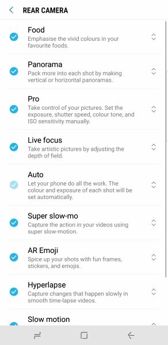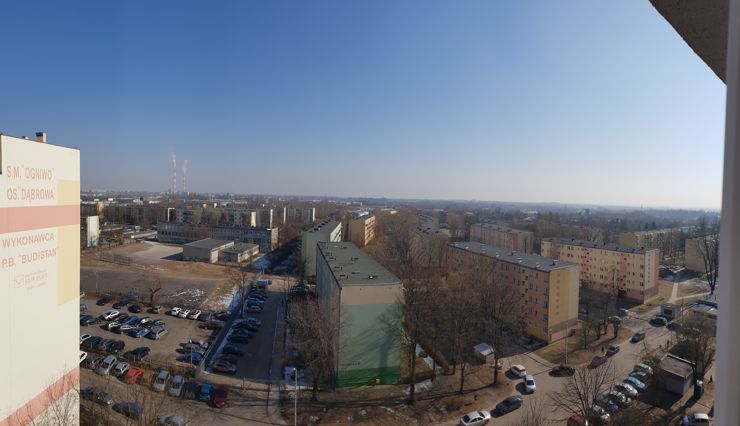Photography and video
photo: Adam Łukowski/GSMchoice.com
Top Samsung models have accustomed us to the fact that they are offering a high quality of photos and videos. And it is no different in this model, we are still dealing with one of the best photography phones. In the Galaxy S9 there is a new and an interesting – for a smartphone – feature.
photo: Adam Łukowski/GSMchoice.com
I am talking about a variable aperture, which switches between f/1.5 and f/2.4. In the auto mode the change cannot be noticed by the user, but we can force it in the manual mode, for example to experiment with the depth of field. When it comes to the Samsung Galaxy S9+ model, we have another matrix – with the f/2.4 tele lens – thanks to which we can use a lossless 2x zoom.
photo: Adam Łukowski/GSMchoice.com
Both matrixes have optical image stabilization, which is a rare thing in dual camera. While the previous camera has 8 megapixels with an f/1.7 aperture.
photo: Adam Łukowski/GSMchoice.com
It is difficult to have any major concerns towards the photography. They are well-lighted, with precisely reflected details and with a decent geometry.
photo: Adam Łukowski/GSMchoice.com
The effects of noise reducing algorithms can only be seen with a large zoom, we can maybe complain about a slight colours balance shift towards the warmer side. The most important thing however, is that photos are still eye-pleasant.
photo: Adam Łukowski/GSMchoice.com
Thanks to the tele lens, the digital zoom works better than usual, the digital background blurring is really nice as well (though it is not perfect), there are no problems with making a great panoramic pic for the first try. HDR works perfectly as well and the manual mode (called the professional one) allows “playing” with photography.
photo: Adam Łukowski/GSMchoice.com
The front camera is decent as well, though it is not ideal. It could use more details, it overexposes some brighter parts of the background as well. As a consolation – we can find here a digital background blurring as well…
photo: Adam Łukowski/GSMchoice.com
If we are talking about recording videos – the “Nine” has a novelty – slow motion. Unfortunately, only with the HD resolutions, but effects are still interesting. In a more “regular” speed, we can record videos in a UHD quality or lower, and in the 2224x1080 pixels format, which is a ratio adjusted to the display of the phone. Just like with photos, there is not much to complain about when it comes to videos.
| Videos from Galaxy S9+ video: GSMchoice.com, via YouTube |
|||
Galaxy S9 and Galaxy S9+ have received a new photography interface. There is no separate sub-menu, now we have a scrollable list. It is a simpler and more comfortable solution, though at the beginning I have switched to the front camera instead of the mode selection rather often – because they are too close to each other. Later on – it was only better, so it only requires getting used to it. The selection of modes can be edited, and besides those mentioned earlier, there is a sport mode, panoramic selfie or… “food”, that is blurring edges of the shot with a slight vignette.
photo: Adam Łukowski/GSMchoice.com
There are artificial intelligence mechanisms in the camera as well. Besides beautifying, there is Bixby Vision, which not only can scan QR codes or business cards, but it offers instant text translation, browsing for interesting places or analysing images, when it comes to the context and even… it is capable of recognizing wine brands and searching for appropriate information.
photo: Adam Łukowski/GSMchoice.com
There is something I have left for the end: AR Emoji icons. We no longer have to apply digital masks or adding rabbit ears – now we can create animated emojis based on our own likeness… Though I would be careful with this likeness.
photo: Adam Łukowski/GSMchoice.com
If the similarity of the digital image does not satisfy us, we can manually make some adjustments, including matching the outfit of the digital character to our own style. Let us say that avatars based on our photos look slightly similar – but you have to judge this by yourself – the character above is supposed to be me. I do not like the effect itself, as much as the universality of GIFs created this way. We can easily send them to social media, via MMS or using communication apps. They work both on Android and iOS phones. The question is – why…? But, maybe you have an answer already?
photo: Adam Łukowski/GSMchoice.com
Source: GSMchoice.com

























































































